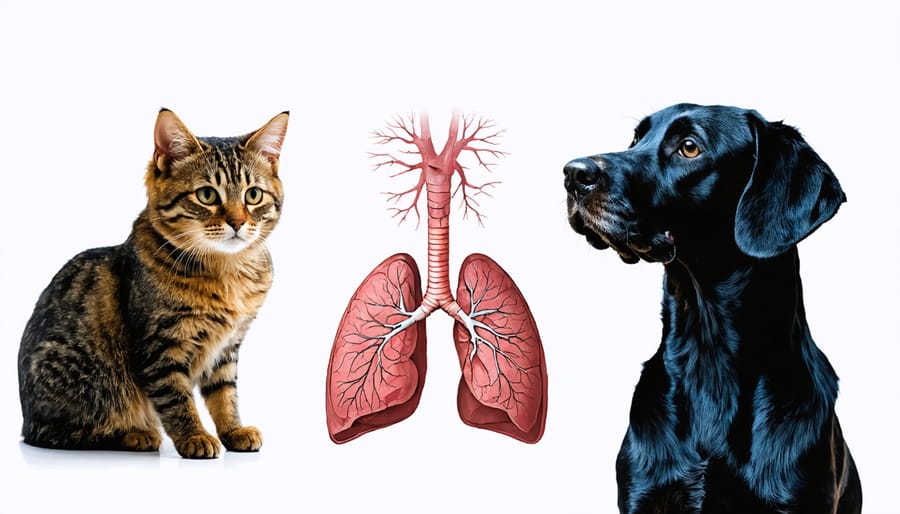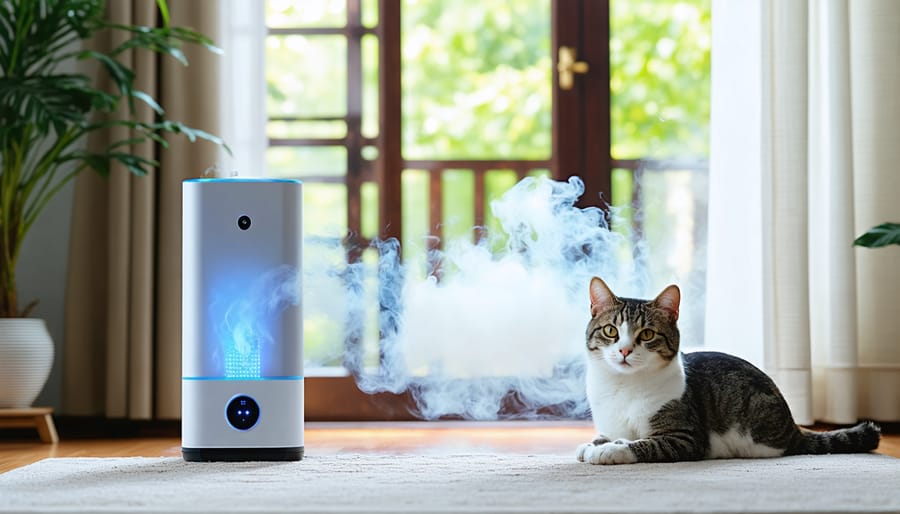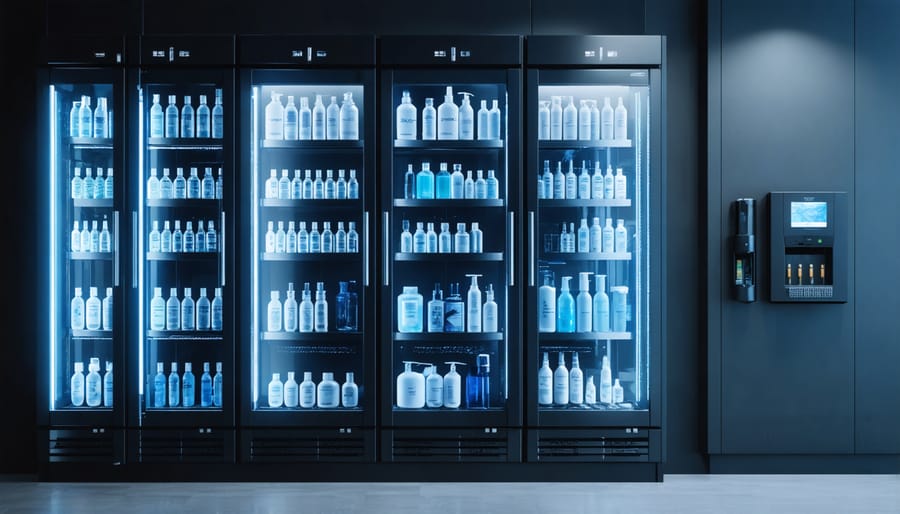Create a dedicated vaping space in a well-ventilated room with open windows and an air purifier to protect your pets from secondhand vapor exposure. Switch to tobacco e-juice options that contain fewer artificial flavourings, reducing potential respiratory irritants for sensitive animals. Store all vaping equipment, e-liquids, and accessories in secured, pet-proof containers placed well out of reach, preventing accidental ingestion of nicotine-containing products.
Install a high-quality exhaust fan to remove vapor efficiently, and establish a consistent vaping schedule when pets can be safely separated from the vaping area. Keep monitoring your pet’s behavior and breathing patterns, watching for signs of respiratory distress or unusual reactions to environmental changes. These practical steps create a safer space where both you and your pets can coexist comfortably, minimizing health risks while maintaining your vaping routine.
Understanding Vapor’s Impact on Pets
How Pets Process Vapor Differently
Pets process vapor differently than humans due to their unique anatomical and physiological characteristics. Respiratory sensitivity in pets is significantly higher than in humans, making them more vulnerable to airborne substances. Their smaller lung capacity and faster breathing rate mean they inhale a higher concentration of vapor relative to their body size.
Cats and dogs have particularly sensitive mucous membranes in their respiratory tract, which can become irritated when exposed to vapor particles. These particles can also settle on their fur, leading to additional exposure when they groom themselves. Small pets like birds, hamsters, and rabbits are even more susceptible due to their extremely delicate respiratory systems and rapid metabolism.
The compounds in vapor, including propylene glycol and vegetable glycerin, can accumulate in pets’ airways more readily than in humans, potentially causing respiratory distress or long-term health issues. This heightened sensitivity means that even minimal exposure to vapor could affect their well-being significantly.

Common Signs of Vapor Sensitivity in Pets
Being alert to your pet’s behavioral changes is crucial when vaping at home. Watch for respiratory symptoms such as coughing, wheezing, or labored breathing, which may indicate vapor sensitivity. Other common signs include excessive sneezing, watery or irritated eyes, and pawing at the face or nose.
Some pets might display behavioral changes like restlessness, avoiding certain rooms, or showing unusual anxiety when you vape. Physical symptoms can include lethargy, decreased appetite, or changes in water consumption. If your pet exhibits any of these signs your pet needs veterinary care, particularly if they persist or worsen.
Cats and small pets may be especially sensitive, often showing symptoms through reduced grooming, changes in litter box habits, or unusual vocalization. Birds are particularly vulnerable to respiratory irritants and may display fluffed feathers, tail bobbing, or decreased activity when exposed to vapor.
Creating a Pet-Safe Vaping Space
Proper Ventilation Strategies
Proper ventilation is crucial when vaping around pets, as their respiratory systems are more sensitive than humans’. Start by designating a specific room for vaping that’s separate from where your pets spend most of their time. Install a high-quality air purifier with HEPA and activated carbon filters to remove vapor particles and residual chemicals from the air.
Ensure your vaping space has adequate natural airflow by opening windows when weather permits. Position a fan near an open window to create directional airflow that pushes vapor outside rather than letting it circulate within the room. Consider installing a ceiling fan to help distribute and remove vapor more effectively.
For apartment dwellers or during cold weather, a bathroom with an exhaust fan can serve as a temporary vaping space. Run the exhaust fan during and for several minutes after vaping to remove lingering vapor. If possible, install a dedicated ventilation system with an exhaust fan that vents directly outside.
Remember to keep doors closed while vaping and maintain good general home ventilation through regular air exchange. Clean or replace air purifier filters according to manufacturer recommendations, and regularly dust surfaces to remove any settled vapor residue. These measures help create a safer environment for your pets while allowing you to continue vaping responsibly.

Designated Vaping Areas
Establishing designated vaping areas is crucial for maintaining a pet-safe environment in your home. Choose a well-ventilated space that’s physically separated from areas where your pets spend most of their time. Ideal locations include a balcony, enclosed porch, or a specific room with windows that can be easily opened.
When selecting your designated vaping area, ensure it has proper airflow by installing a fan or air purifier specifically designed for vapor removal. Keep the door closed while vaping and for several minutes afterward to prevent vapor from drifting into other areas of your home.
Store all vaping equipment, e-liquids, and accessories in secure, pet-proof containers within your designated area. Consider using lockable storage boxes or high shelves that are completely inaccessible to your pets. This prevents accidental exposure to potentially harmful materials.
Maintain cleanliness in your vaping area by regularly wiping down surfaces where residue might accumulate. Empty ashtrays or disposal containers promptly, and never leave vaping equipment unattended where pets might access them.
If you live in an apartment or smaller space, consider creating a vaping schedule that aligns with times when your pets are in another room or sleeping. Always ensure adequate time for proper ventilation between vaping sessions and when pets re-enter the space.
Safe Storage Solutions
Securing E-Liquids and Devices
Proper storage of e-liquids and vaping devices is crucial for pet safety. Keep all vaping supplies in a dedicated lockable container or cabinet that’s well out of your pet’s reach. High shelves or locked drawers are ideal storage locations. Never leave e-liquids, pods, or devices on low tables, countertops, or other easily accessible surfaces where curious pets might investigate them.
Store e-liquids in their original childproof containers and ensure caps are tightly sealed after each use. If you notice any leakage, clean it immediately and thoroughly to prevent pets from coming into contact with the liquid. Consider using a storage solution with separate compartments to organize devices, batteries, and e-liquids, making it easier to notice if anything is missing or potentially accessible to pets.
When charging devices, keep cables and charging stations away from areas where pets typically rest or play. Always dispose of used pods, coils, and empty e-liquid bottles in sealed containers that pets cannot access. Remember that pets are naturally curious and may be attracted to sweet-smelling e-liquids, so maintaining vigilant storage practices is essential for their safety.

Emergency Response Plan
If your pet ingests any vaping products, immediate action is crucial. First, remove any remaining product from your pet’s reach and try to determine what they consumed (e-liquid, device parts, or batteries). Call your veterinarian or the nearest emergency animal hospital immediately – don’t wait for symptoms to appear.
For e-liquid ingestion, do not induce vomiting unless specifically instructed by a veterinary professional. Keep the product packaging to show your vet, as this contains important information about nicotine concentration. If possible, estimate how much was consumed.
Keep these emergency numbers handy:
– Your regular veterinarian
– Local 24-hour emergency veterinary clinic
– Animal Poison Control: 1-888-226-4435 (Canada)
Watch for symptoms including:
– Vomiting or drooling
– Tremors or seizures
– Irregular breathing
– Elevated heart rate
– Lethargy or weakness
While seeking help, keep your pet calm and comfortable. Monitor their breathing and behavior. If they’re unconscious or having severe symptoms, transport them to the nearest emergency veterinary facility immediately. Time is critical in nicotine poisoning cases, so don’t delay seeking professional help.
Best Practices for Pet Owners Who Vape
Timing Your Vaping Sessions
Timing your vaping sessions strategically is crucial for minimizing your pet’s exposure to secondhand vapor. The best practice is to vape outdoors whenever possible, ensuring your pets remain inside during these sessions. If outdoor vaping isn’t feasible, designate a specific room or area in your home that your pets don’t frequently access.
Consider vaping when your pets are in another room or sleeping, and always allow 15-20 minutes for proper ventilation before letting them back into the space. Morning sessions before feeding time or late evening after your pet’s last outdoor activity can be ideal times. This scheduling helps to maintain your pet’s immune system by reducing their exposure to potentially harmful substances.
If you have a regular vaping routine, try to coordinate it with times when you’re already separated from your pets, such as before leaving for work or after putting them in their designated sleeping area. Remember to always wash your hands after vaping and before handling your pets or their belongings to minimize contact with residual substances.
Cleaning and Maintenance
Regular cleaning is essential to minimize residual vapor exposure for your pets. Establish a daily cleaning routine that includes wiping down surfaces where vapor might settle, particularly windowsills, tables, and pet beds. Use pet-safe cleaning products and microfiber cloths to effectively capture vapor residue without introducing harmful chemicals into your pet’s environment.
Pay special attention to your vaping area by emptying ashtrays promptly and storing all vaping equipment in sealed containers when not in use. Wash your hands thoroughly after vaping to avoid transferring residue to your pets during interactions.
Consider investing in an air purifier with a HEPA filter to help remove airborne particles. Place these units strategically in rooms where you vape and where your pets spend most of their time. Remember to regularly clean or replace filters according to manufacturer guidelines.
Vacuum carpets and upholstery frequently, as these surfaces can trap vapor particles. Wash pet bedding weekly and ensure proper ventilation throughout your home by opening windows when weather permits. These simple maintenance steps can significantly reduce your pet’s exposure to vaping residue while maintaining a clean, healthy environment.
Creating a pet-safe vaping environment requires consistent attention to detail and a commitment to responsible vaping practices. By keeping your vaping equipment securely stored, maintaining proper ventilation, and always vaping in designated areas away from your pets, you can significantly reduce potential risks. Remember to clean surfaces regularly, dispose of e-liquid containers properly, and never leave vaping supplies where curious pets might access them. Most importantly, recognize that your pets rely on you to maintain their safe and healthy environment. Taking these precautions not only protects your beloved companions but also allows you to enjoy vaping while being a responsible pet owner. If you ever notice unusual symptoms in your pets, don’t hesitate to consult with a veterinary professional for guidance.
